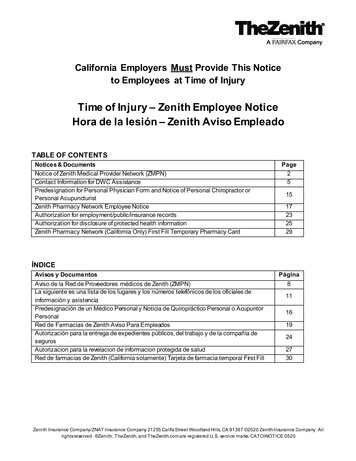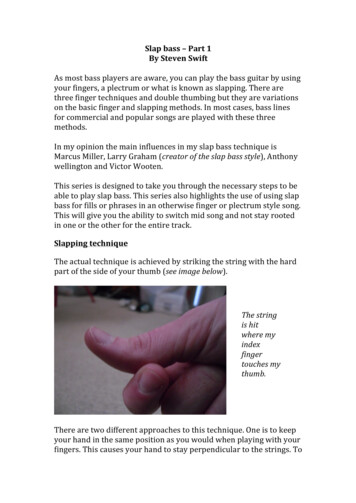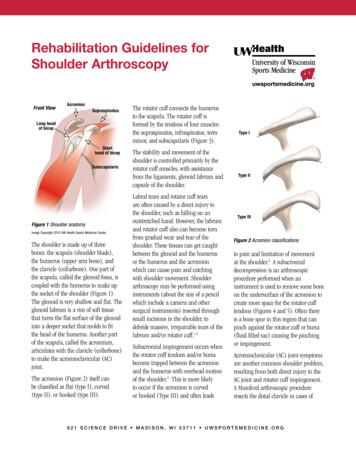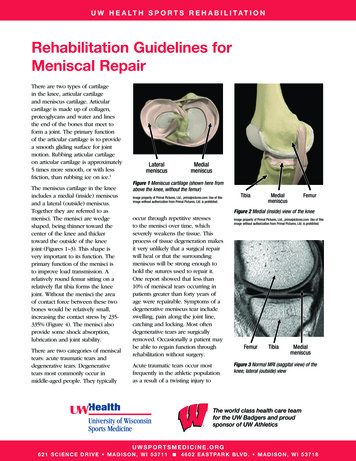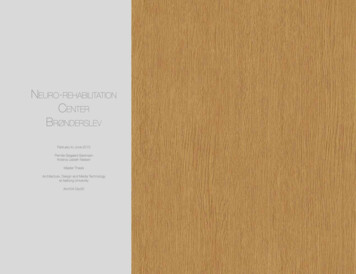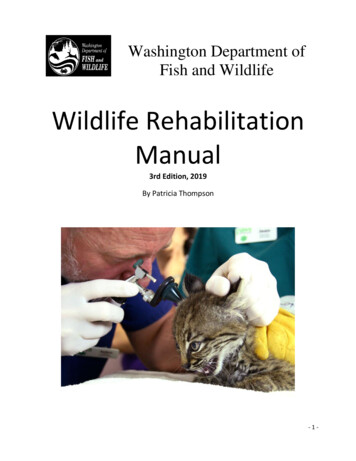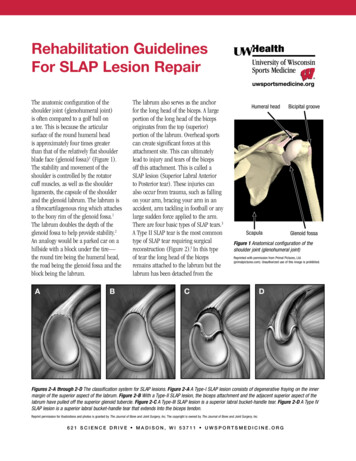
Transcription
Rehabilitation GuidelinesFor SLAP Lesion RepairThe anatomic configuration of theshoulder joint (glenohumeral joint)is often compared to a golf ball ona tee. This is because the articularsurface of the round humeral headis approximately four times greaterthan that of the relatively flat shoulderblade face (glenoid fossa)1 (Figure 1).The stability and movement of theshoulder is controlled by the rotatorcuff muscles, as well as the shoulderligaments, the capsule of the shoulderand the glenoid labrum. The labrum isa fibrocartilagenous ring which attachesto the bony rim of the glenoid fossa.1The labrum doubles the depth of theglenoid fossa to help provide stability.2An analogy would be a parked car on ahillside with a block under the tire—the round tire being the humeral head,the road being the glenoid fossa and theblock being the labrum.ABThe labrum also serves as the anchorfor the long head of the biceps. A largeportion of the long head of the bicepsoriginates from the top (superior)portion of the labrum. Overhead sportscan create significant forces at thisattachment site. This can ultimatelylead to injury and tears of the bicepsoff this attachment. This is called aSLAP lesion (Superior Labral Anteriorto Posterior tear). These injuries canalso occur from trauma, such as fallingon your arm, bracing your arm in anaccident, arm tackling in football or anylarge sudden force applied to the arm.There are four basic types of SLAP tears.3A Type II SLAP tear is the most commontype of SLAP tear requiring surgicalreconstruction (Figure 2).3 In this typeof tear the long head of the bicepsremains attached to the labrum but thelabrum has been detached from theHumeral headScapulaBicipital grooveGlenoid fossaFigure 1 Anatomical configuration of theshoulder joint (glenohumeral joint)Reprinted with permission from Primal Pictures, Ltd.(primalpictures.com). Unauthorized use of this image is prohibited.CDFigures 2-A through 2-D The classification system for SLAP lesions. Figure 2-A A Type-I SLAP lesion consists of degenerative fraying on the innermargin of the superior aspect of the labrum. Figure 2-B With a Type-II SLAP lesion, the biceps attachment and the adjacent superior aspect of thelabrum have pulled off the superior glenoid tubercle. Figure 2-C A Type-III SLAP lesion is a superior labral bucket-handle tear. Figure 2-D A Type IVSLAP lesion is a superior labral bucket-handle tear that extends Into the biceps tendon.Reprint permission for illustrations and photos is granted by The Journal of Bone and Joint Surgery, Inc. The copyright is owned by The Journal of Bone and Joint Surgery, Inc.6 2 1 S c i e n c e D r i v e M a d i s o n , W I 5 3 7 1 1 u ws p o r t sm e d i c i n e . o r g
Rehabilitation Guidelines For SLAP Lesion Repairbony glenoid.4 This is repaired surgicallyby placing suture anchors (Figure 3)in the glenoid fossa, passing suturesthrough the labrum and then tyingspecial surgical knots to approximate thelabrum back to the bony glenoid rim.Full return to throwing and contactsports occurs in 80-90% of athletes.4, 5Successful return to sport and activity isdependent on following post-operativeprecautions and completing a structuredpost-operative rehabilitation program.Our rehabilitation program is outlinedbelow. The rehabilitation guidelinesare presented in a criterion basedprogression. General time frames aregiven for reference to the average, butindividual patients will progress atdifferent rates depending on their age,associated injuries, pre-injury healthstatus, rehabilitation compliance andinjury severity. These factors will alsoaffect how long it takes each individualto meet the required criteria for return tosport and activity.42Figure 3. The first illustration shows a Type II SLAP tear extending from 10:00 to 2:00. The secondillustration shows this tear repaired with sutures and anchors anterior to and posterior to the longhead of the biceps. The number of suture anchors needed varies from case to case.6 2 1 S c i e n c e D r i v e M a d i s o n , W I 5 3 7 1 1 u ws p o r t sm e d i c i n e . o r g
Rehabilitation Guidelines For SLAP Lesion RepairPHASE I (Surgery to 4-6 weeks after surgery)Appointments Rehabilitation appointments begin within 7 days of surgery, continue 1-2 times per weekRehabilitation Goals Protection of the post-surgical shoulder Activation of the stabilizing muscles of the glenohumeral and scapulo-thoracic jointsPrecautions Sling immobilization required for soft tissue healing Hypersensitivity in axillary nerve distribution is a common occurrence No long head biceps tension for 6 weeks to protect repaired tissues – this includesavoiding range of motion with long lever arm shoulder flexion, as well as resistedsupination or elbow flexion Limit external rotation to 40 in neutral for the first 4 weeks. Avoid abduction andexternal rotation for 6 weeks No extension or horizontal abduction past body for 4 weeks Dr. Scerpella’s patients should also avoid forward flexion past 130 for 6 weeks.Range of Motion Exercises Gentle active/active assistive range of motion for elbow and wrist Pain free, gentle passive range of motion for shoulder flexion, abduction, internalrotation and external rotation within the limits of the precautions.(Please do not exceed the rangeof motion specified for eachexercise and time period)Suggested TherapeuticExercise Begin week 3, sub-maximal shoulder isometrics for internal rotation, external rotation,abduction and adduction within the limits of the precautions Hand gripping Cervical spine and scapular active range of motion Desensitization techniques for axillary nerve distributionCardiovascular Fitness Walking, stationary bike - sling on No treadmill (Avoid running and jumping due to the distractive forces that canoccur at landing)PHASE II (begin after meeting Phase I criteria, usually 6 to 12 weeks after surgery)Appointments Rehabilitation appointments are once every 1-2 weeksRehabilitation Goals Full active range of motion Full rotator cuff strength in a neutral positionPrecautions Gradual initiation of biceps tension from weeks 6-8 to protect repaired tissues No passive range of motion for abduction with external rotation or extensionRange of Motion Exercises Active range of motion for shoulder flexion in side lying to lessen biceps tension Active range of motion for shoulder abduction in supine or prone to lessen biceps tension Active range of motion for shoulder internal rotation – avoid internal rotation up theback type stretching since internal rotation and extension may place too much stress onthe healing superior labrum(Please do not exceed the rangeof motion specified for eachexercise and time period)36 2 1 S c i e n c e D r i v e M a d i s o n , W I 5 3 7 1 1 u ws p o r t sm e d i c i n e . o r g
Rehabilitation Guidelines For SLAP Lesion RepairSuggested TherapeuticExercise Scapular squeezes Internal and external rotation in neutral with exercise band resistance to neutral – makesure patient is not supinating with external rotation movementCardiovascular Fitness Walking, stationary bike without using arms (No Airdyne) No treadmill, swimming or runningPHASE III (begin after meeting Phase II criteria, usually 10 weeks after surgery)Appointments Rehabilitation appointments are 1-2 times per weekPhase III Goals Full active range of motion in all cardinal planes with normal scapulo-humeralmovement Normal (rated 5/5) rotator cuff strength at 90 of shoulder abduction in the scapularplane Normal (rated 5/5) peri-scapular strengthPrecautions All exercises and activities to remain non-provocative and low to medium velocity Avoid activities where there is a higher risk for falling or outside forces to be applied tothe arm No swimming, throwing or overhead sports Patients can develop posterior capsule tightness that inhibits rehabilitation progress;continue to evaluate for this and treat if necessarySuggested TherapeuticExerciseMobilization and motion Posterior glides and sleeper stretch if posterior capsule tightness is present uponassessmentStrength and Stabilization Flexion in prone, horizontal abduction in prone, full can exercise, D1 and D2 diagonalsin standing Theraband/cable column/ dumbbell (light resistance/high repetition) internal rotationand external rotation in 90 of abduction Rowing with Theraband or resistance machines Balance board in push-up position (with rhythmic stabilization), prone Swiss ball walkouts, rapid alternating movements in supine, and D2 diagonal closed kinetic chairstabilization with narrow base of support4Cardiovascular Fitness Walking, biking, stairmaster and running (if Phase II criteria are met) No swimmingProgression Criteria Patient may progress to Phase IV if they have met the above stated goals and have noapprehension, internal impingement or active irritation/inflamation of the long head ofthe biceps6 2 1 S c i e n c e D r i v e M a d i s o n , W I 5 3 7 1 1 u ws p o r t sm e d i c i n e . o r g
Rehabilitation Guidelines For SLAP Lesion RepairPHASE IV (begin after meeting Phase III criteria, usually 16 weeks after surgery)Appointments Rehabilitation appointments are 1 time every 3 weeksPhase IV Goals Patient to demonstrate stability with higher velocity movements and change ofdirection movements Normal (rated 5/5) rotator cuff strength with multiple repetition testing at 90 ofshoulder abduction in the scapular plane Full multi-plane active shoulder range of motionPrecautions Progress gradually into provocative exercises by beginning with low velocity,known movement patternsSuggested Therapeutic ExerciseMobilization and motion Posterior glides and sleeper stretch if posterior capsule tightness is present uponassessmentStrength and Stabilization Dumbbell and medicine ball exercises that incorporate trunk rotation and controlwith rotator cuff strengthening at 90 of shoulder abduction; begin workingtowards more functional activities by emphasizing core and hip strength andcontrol with shoulder exercises Theraband/cable column/ dumbbell internal rotation and external rotation in90 of abduction Rowing with Theraband or resistance machines Higher velocity strengthening and control, such as inertial, plyometrics and rapidexercise band drills. Plyometrics should start with 2 hands below shoulder heightand progress to overhead, then back to below shoulder with one hand, progressingagain to overhead Begin education in sport specific biomechanics with very initial program forthrowing, swimming or overhead racquet sportsCardiovascular Fitness Walking, biking, stairmaster and running (if Phase III criteria are met) No swimmingProgression Criteria Patient may progress to Phase V if they have met the above stated goals and haveno apprehension or internal impingement signsPHASE V (begin after meeting Phase IV criteria, usually 22 weeks after surgery)5Appointments Rehabilitation appointments are 1 time every 2-3 weeksPhase V Goals Patient to demonstrate stability with higher velocity movements and change ofdirection movements that replicate sport specific patterns (including swimming,throwing, etc.) No apprehension or instability with high velocity overhead movements Improve core and hip strength and mobility to eliminate any compensatorystresses to the shoulder Work capacity cardiovascular endurance for specific sport or work demands6 2 1 S c i e n c e D r i v e M a d i s o n , W I 5 3 7 1 1 u ws p o r t sm e d i c i n e . o r g
Rehabilitation Guidelines For SLAP Lesion RepairPrecautions Progress gradually into sport specific movement patternsSuggested Therapeutic ExerciseMobilization and motion Posterior glides and sleeper stretch if posterior capsule tightness is present uponassessmentStrength and Stabilization Dumbbell and medicine ball exercises that incorporate trunk rotation and controlwith rotator cuff strengthening at 90 of shoulder abduction and higher velocities;begin working towards more sport specific activities Initiate throwing program, overhead racquet program or return to swimmingprogram depending on the athlete’s sport High velocity strengthening and dynamic control, such as plyometrics and rapidexercise band drillsCardiovascular Fitness Design to use sport specific energy systemsProgression Criteria Patient may return to sport after receiving clearance from the Orthopedic surgeonand the physical therapist/athletic trainerThese rehabilitation guidelines were developed collaboratively by Marc Sherry, PT, DPT, LAT, CSCS(msherry@uwhealth.org) and the UW Health Sports Medicine physician group.Updated 03/2011REFERENCES2. Perry J. Anatomy and biomechanics ofthe shoulder in throwing, swimming,gymnastics, and tennis. Clin Sports Med.Jul 1983;2(2):247-270.3. Barber A, Field LD, Ryu R. Biceps tendonand superior labrum injuries: decisionmarking. J Bone Joint Surg Am. Aug2007;89(8):1844-1855.5. Funk L, Snow M. SLAP tears of theglenoid labrum in contact athletes. Clin JSport Med. Jan 2007;17(1):1-4.4. Park HB, Lin SK, Yokota A, McFarland EG.Return to play for rotator cuff injuriesand superior labrum anterior posterior(SLAP) lesions. Clin Sports Med. Jul2004;23(3):321-334, vii.At UW Health, patients may have advanced diagnostic and /or treatment options, or may receive educational materials that vary from this information. Please be aware that this information is not intended to replacethe care or advice given by your physician or health care provider. It is neither intended nor implied to be a substitute for professional advice. Call your health provider immediately if you think you may have a medicalemergency. Always seek the advice of your physician or other qualified health provider prior to starting any new treatment or with any question you may have regarding a medical condition.Copyright 2011 UW Health Sports Medicine Center66 2 1 S c i e n c e D r i v e M a d i s o n , W I 5 3 7 1 1 u ws p o r t sm e d i c i n e . o r gSM-27335-11
Dumbbell and medicine ball exercises that incorporate trunk rotation and control with rotator cuff strengthening at 90 of shoulder abduction; begin working towards more functional activities by emphasizing core and hip strength and control with shoulder exercises
